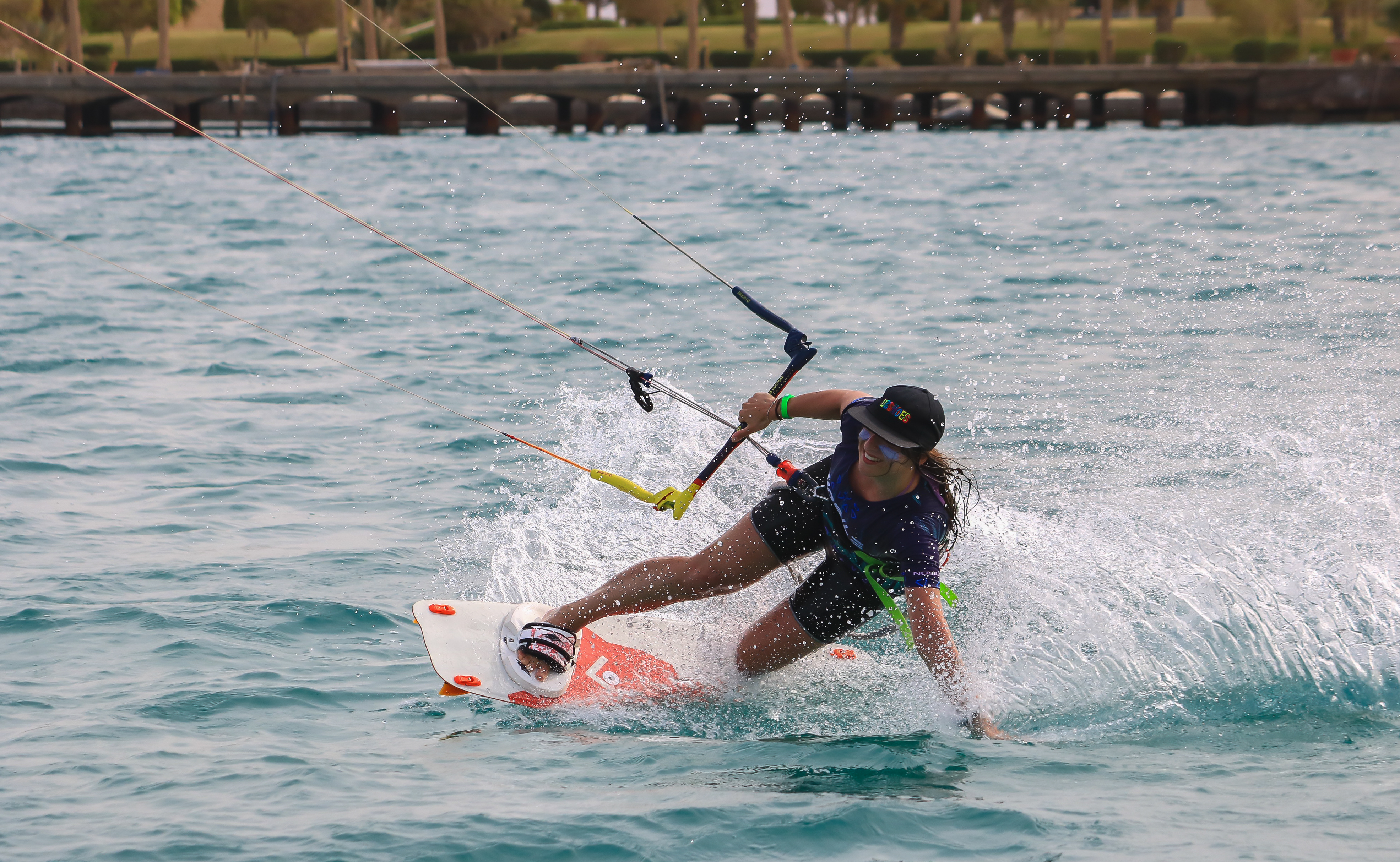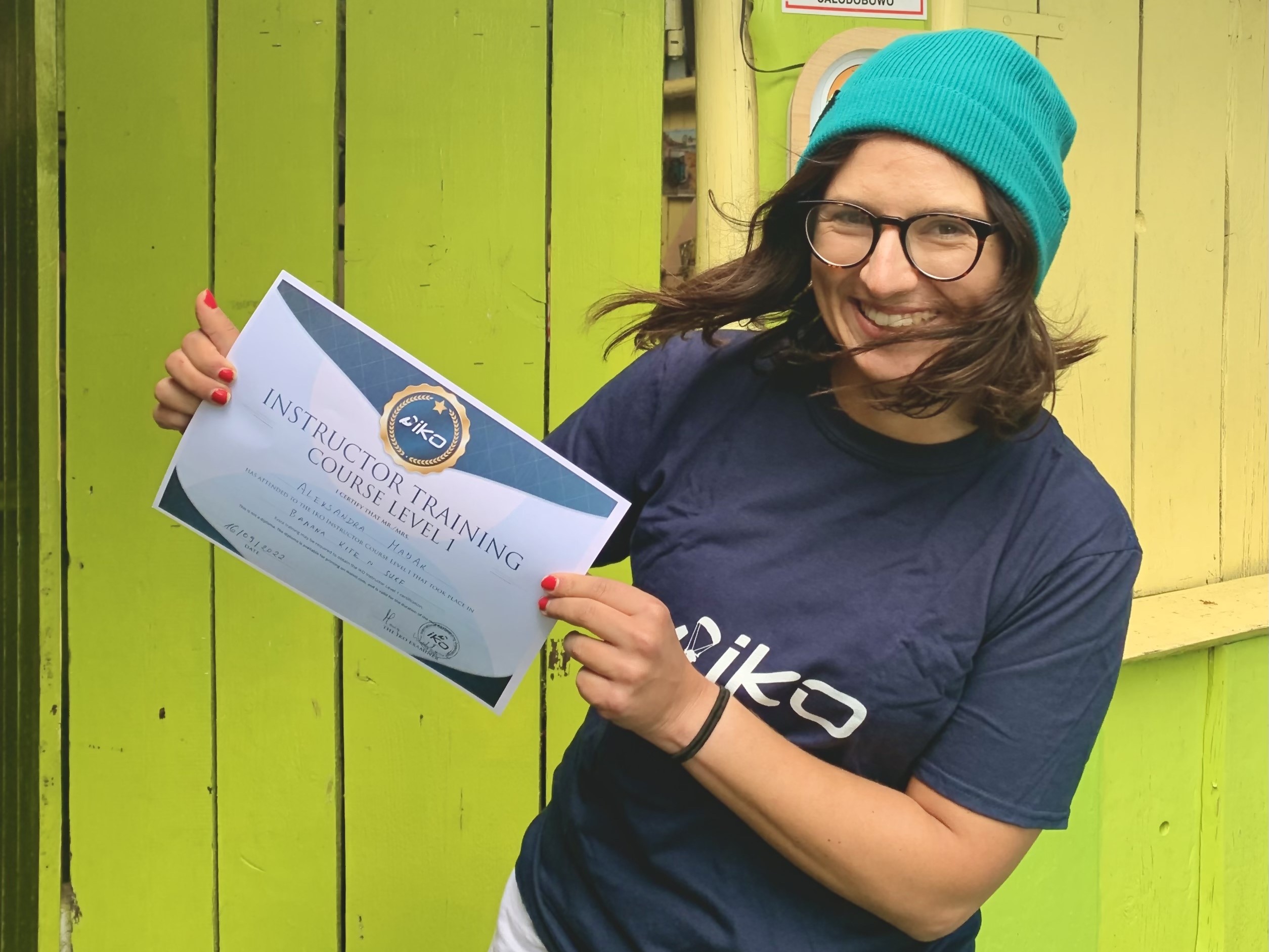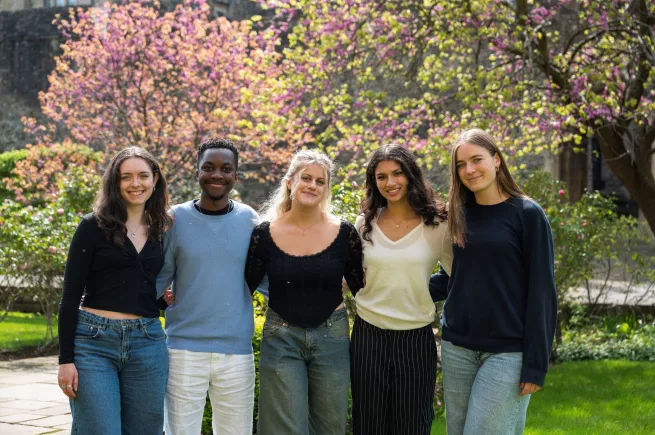Freedom begins above 25 knots: from New College to kitesurfing pro-camp
By Aleks Majak
Aleks Majak is a New College DPhil student, reading comparative literature and writing about changes in Anglo-American literary criticism in the mid-1960s. The New College Sports Grant recently supported her kitesurfing pro-camp training and this summer, after the submission of her thesis, she qualified as a kitesurfing instructor.
Image: Kacper Matuszewski
It must have been around the summer of 2003 when I saw kitesurfing for the first time – an extreme sport that I would later fall in love with. Somewhere around Hel peninsula by the Baltic sea and curious about the little-known sport, my dad took his first kite lesson. My usual childhood memories from the Polish coastline were idyllic summer camps, but this time kitesurfing stole my attention. This was partly for its beauty and its dynamism, but also because by the end of the lesson the instructor became hopelessly entangled in the 25-metre lines that connect the bar to the kite, carrying full power over so-called ‘wind window’. Thankfully he escaped with cutting ‘only’ half of his calf, but whilst accidents like that are rare – so rare, in fact, that I’ve never seen a similar scene ever again – this early, dramatic encounter really drove home the ‘extreme’ component of ‘extreme sport’.
Twenty years later kitesurfing is safer, more accessible, and much more popular. The discipline has expanded its horizons over time, with international teams now representing different kites and boards like Nobile, Duotone, Eleveight, North, Core and Ozone. At the same time, pro-riders are not just focused on their sports performance - they use their status as athletes to advocate for a variety of charitable causes and environmental campaigns. To give my friend and Core-team pro-rider Willow River Tonkin as an example. Riding the wave of its growing popularity, kitesurfing made its Olympic debut in 2018 at the Youth Olympic Games in Buenos Aires and it will soon take Olympic Games Paris 2024 by storm. But how does one begin in kitesurfing? And what does New College have to do with my kitesurfing adventures and becoming a kitesurfing instructor this summer?
I began kitesurfing over ten years ago at a kite spot on Rhodes island in Greece, at the time known more for its parties and community of young people sleeping semi-legally in tents in the bushes to save up money for a kite than for the safest kite conditions. When you start off in kitesurfing what you need most of all is space where you can splash safely into the water – again, and again. The wide lagoons with warm and calm waters are ideal. Once you know the basics and are comfortable with getting back to shore, the possibilities become endless. Buying your own kite, which can serve you for many years, means you no longer need to pay for any courses, and the best next step is to practice. In England the best conditions to try out closest to Oxford are kite spots near Southampton; areas around Whitstable in Kent; the long beaches of East Sussex; or the west side of Cornwall.

Image: Kite Motion
I had never trained professionally up to recently, but for the first few years I had a chance to kite more often (3-4 weeks a year). Back then, I had far too little experience to kitesurf at the spots I have since visited. For instance, the famous Tarifa spot in Spain required me to jump over huge waves, breaking over me before I knew how to jump high enough. So you learn, quickly. At another spot, the water was so full of algae that if you dropped the kite into the water the lines would get too heavy to lift (or ‘re-launch’) your kite. This is also where I somehow managed to crash my kite into the only visible tree on a spot.
Most of the time, kitesurfing is a spectacular experience; the sense of freedom as you speed over water is incomparable to any other sport I know. With a little time I gained confidence in the style and dynamism of riding and, later on, with numerous tricks and rotations. In 2016 I qualified as an instructor’s assistant by taking a course recognised by International Kiteboarding Association (IKO) but unfortunately I had little further opportunity to practise since then. After a break of a few years, however, I was able to return to my beloved sport. The New College Sports and Cultural Events Grant supported my passion by contributing to my pro-camp training, giving me the chance to train with one of the world champions of the sport – Kasia Lange from the Nobile team, specialising in freestyle kitesurfing.

Image: Kite Motion
Pro-camp is a 7- or 10-day period of intense training that begins with early-morning yoga, followed by a warm-up, then the preparation and pumping of the kites. For the first session, we kicked on the water at 9 am. The pro-camp I attended between HT and TT took place in the Soma Bay spot in Egypt, and the next one will be in the Baltic Sea this July. Thanks to Lange’s coaching skills, this year I also started to jump unhooked. Using this technique, just before jumping you take the kite off from the harness that usually connects you to the hook, taking most of the pressure off your hand. At the moment of getting off the hook, the full power of the kite is released while all the pressure moves to your arms. This freestyle technique enables a kind of ‘vacuum’ that pro-kiters fill with the most difficult tricks: multiple rotations, hanging upside down, and generally pushing the limits of their performance. All these manoeuvres occur at high speed, making jumping unhooked a true adrenaline rush. It exemplifies everything I love about this sport, but there is still much I am yet to learn. This September, after having spent intense 40 hours on very different type of teaching than I’ve done at Oxford I become IKO kitesurfing instructor. If anyone from New College and beyond has any questions about ‘how to start kitsurfing’, do email me!
I am profoundly grateful to New College for making it possible for me to get hooked again, returning to my much-missed training.

Image: Banana Kite

We aim to make New College your home away from home.
